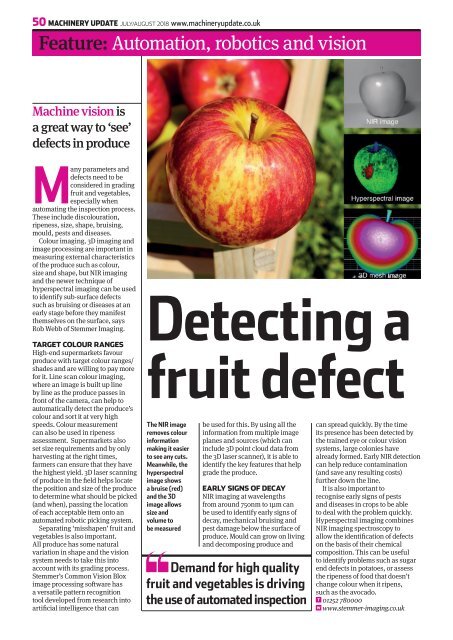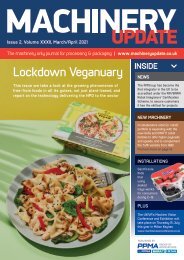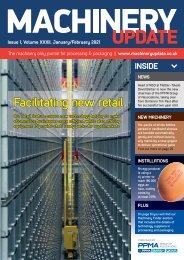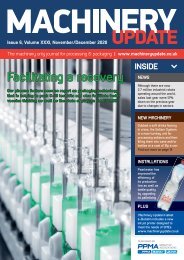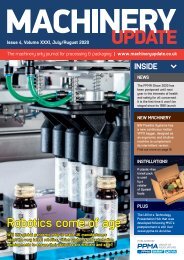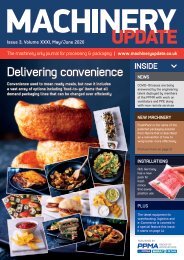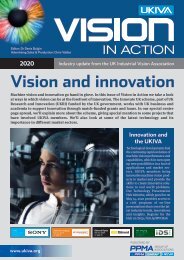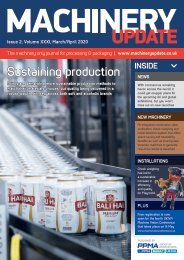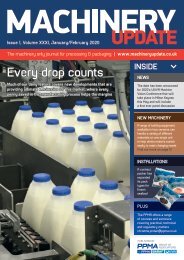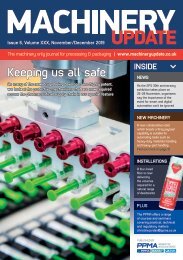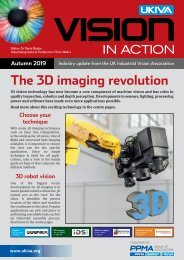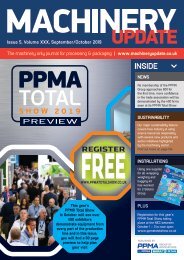July August hi-res with ads
Create successful ePaper yourself
Turn your PDF publications into a flip-book with our unique Google optimized e-Paper software.
50 MACHINERY UPDATE JULY/AUGUST 2018 www.mac<strong>hi</strong>neryupdate.co.uk<br />
Feature: Automation, robotics and vision<br />
Mac<strong>hi</strong>ne vision is<br />
a great way to ‘see’<br />
defects in produce<br />
Many parameters and<br />
defects need to be<br />
considered in grading<br />
fruit and vegetables,<br />
especially when<br />
automating the inspection process.<br />
These include discolouration,<br />
ripeness, size, shape, bruising,<br />
mould, pests and diseases.<br />
Colour imaging, 3D imaging and<br />
image processing are important in<br />
measuring external characteristics<br />
of the produce such as colour,<br />
size and shape, but NIR imaging<br />
and the newer technique of<br />
hyperspectral imaging can be used<br />
to identify sub-surface defects<br />
such as bruising or diseases at an<br />
early stage before they manifest<br />
themselves on the surface, says<br />
Rob Webb of Stemmer Imaging.<br />
TARGET COLOUR RANGES<br />
High-end supermarkets favour<br />
produce <strong>with</strong> target colour ranges/<br />
shades and are willing to pay more<br />
for it. Line scan colour imaging,<br />
where an image is built up line<br />
by line as the produce passes in<br />
front of the camera, can help to<br />
automatically detect the produce’s<br />
colour and sort it at very <strong>hi</strong>gh<br />
speeds. Colour measurement<br />
can also be used in ripeness<br />
assessment. Supermarkets also<br />
set size requirements and by only<br />
harvesting at the right times,<br />
farmers can ensure that they have<br />
the <strong>hi</strong>ghest yield. 3D laser scanning<br />
of produce in the field helps locate<br />
the position and size of the produce<br />
to determine what should be picked<br />
(and when), passing the location<br />
of each acceptable item onto an<br />
automated robotic picking system.<br />
Separating ‘misshapen’ fruit and<br />
vegetables is also important.<br />
All produce has some natural<br />
variation in shape and the vision<br />
system needs to take t<strong>hi</strong>s into<br />
account <strong>with</strong> its grading process.<br />
Stemmer’s Common Vision Blox<br />
image processing software has<br />
a versatile pattern recognition<br />
tool developed from <strong>res</strong>earch into<br />
artificial intelligence that can<br />
Detecting a<br />
fruit defect<br />
The NIR image<br />
removes colour<br />
information<br />
making it easier<br />
to see any cuts.<br />
Meanw<strong>hi</strong>le, the<br />
hyperspectral<br />
image shows<br />
a bruise (red)<br />
and the 3D<br />
image allows<br />
size and<br />
volume to<br />
be measured<br />
be used for t<strong>hi</strong>s. By using all the<br />
information from multiple image<br />
planes and sources (w<strong>hi</strong>ch can<br />
include 3D point cloud data from<br />
the 3D laser scanner), it is able to<br />
identify the key featu<strong>res</strong> that help<br />
grade the produce.<br />
EARLY SIGNS OF DECAY<br />
NIR imaging at wavelengths<br />
from around 750nm to 1µm can<br />
be used to identify early signs of<br />
decay, mechanical bruising and<br />
pest damage below the surface of<br />
produce. Mould can grow on living<br />
and decomposing produce and<br />
Demand for <strong>hi</strong>gh quality<br />
fruit and vegetables is driving<br />
the use of automated inspection<br />
can spread quickly. By the time<br />
its p<strong>res</strong>ence has been detected by<br />
the trained eye or colour vision<br />
systems, large colonies have<br />
already formed. Early NIR detection<br />
can help reduce contamination<br />
(and save any <strong>res</strong>ulting costs)<br />
further down the line.<br />
It is also important to<br />
recognise early signs of pests<br />
and diseases in crops to be able<br />
to deal <strong>with</strong> the problem quickly.<br />
Hyperspectral imaging combines<br />
NIR imaging spectroscopy to<br />
allow the identification of defects<br />
on the basis of their chemical<br />
composition. T<strong>hi</strong>s can be useful<br />
to identify problems such as sugar<br />
end defects in potatoes, or assess<br />
the ripeness of food that doesn’t<br />
change colour when it ripens,<br />
such as the avocado.<br />
T 01252 780000<br />
W www.stemmer-imaging.co.uk


